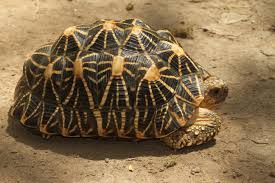Indian Star Tortoise:

Researchers have identified two genetically distinct groups of the Indian star tortoise species namely northwestern and southern.
- Indian Star Tortoise name comes from the star-like patterns that feature on its high-domed shell.
- It has very distinctive patterns and its highly rounded shell makes it popular in the world’s trade in exotic pets.
- They occupy a wide variety of habitats, including semi-arid lowland forests, thorn scrub forests, semi-desert and arid grasslands.
- This species has a high tolerance for habitats that are seasonally wet or dry, with many populations inhabiting areas with a monsoon or rainy season followed by a long hot and dry period.
- It is endemic to the subcontinent and resides in arid pockets of northwest India (bordering Pakistan), South India, and Sri Lanka. However, members of the species have also been found in people’s homes as far afield as Canada and the U.S.
- It is generally crepuscular, which means they are active in the early morning and the late afternoon during dry, hot weather.
- Indian star tortoises are mainly herbivores and mostly eat grasses, herbaceous leaves, flowers etc.
- Conservation status:
- IUCN: VulnerableCITES: Appendix I
- Wildlife (Protection) Act 1972: Schedule I




